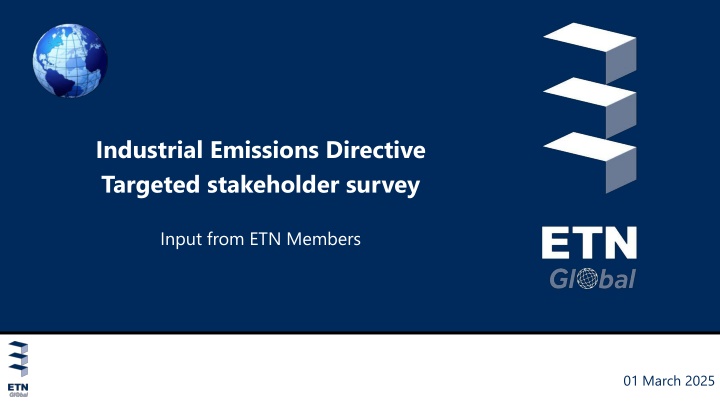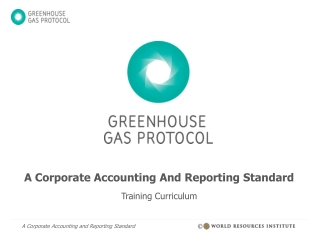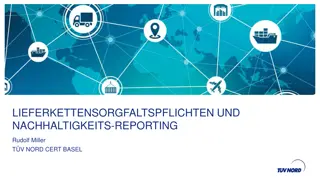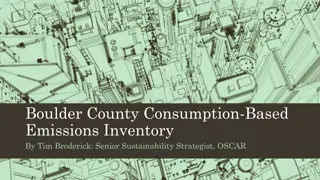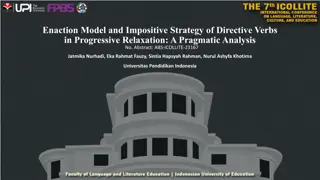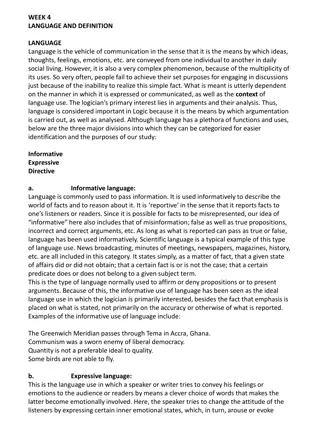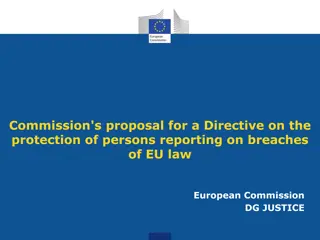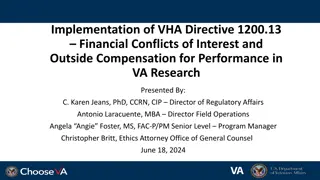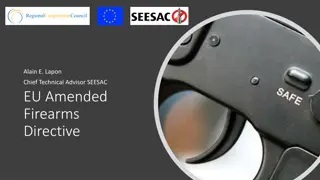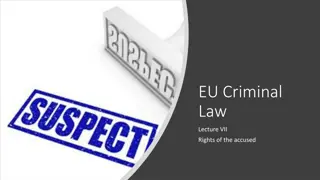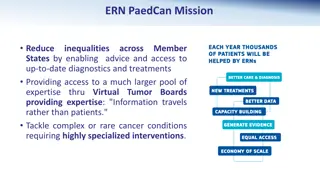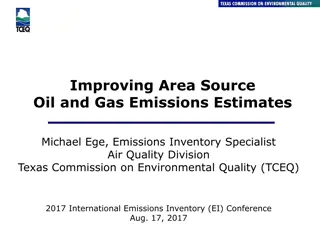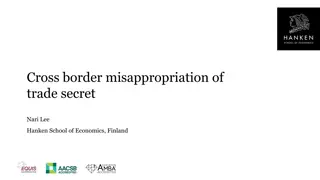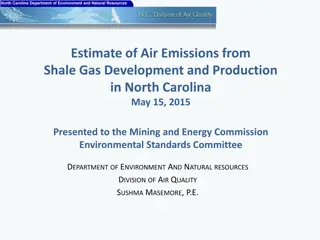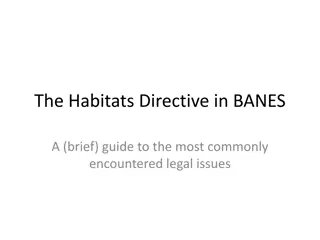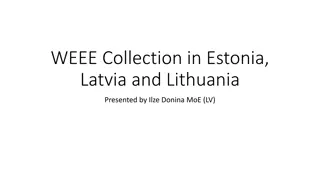Industrial Emissions Directive Stakeholder Survey Insights
This survey captures feedback from ETN members on key themes related to the Industrial Emissions Directive (IED), covering topics such as pollution reduction, scope sectors, environmental impacts, and innovation in pollution prevention. Stakeholders provide input on the effectiveness of IED in controlling pollution, its impact on sustainability, competitiveness, and innovation in industrial activities."
Download Presentation

Please find below an Image/Link to download the presentation.
The content on the website is provided AS IS for your information and personal use only. It may not be sold, licensed, or shared on other websites without obtaining consent from the author.If you encounter any issues during the download, it is possible that the publisher has removed the file from their server.
You are allowed to download the files provided on this website for personal or commercial use, subject to the condition that they are used lawfully. All files are the property of their respective owners.
The content on the website is provided AS IS for your information and personal use only. It may not be sold, licensed, or shared on other websites without obtaining consent from the author.
E N D
Presentation Transcript
Industrial Emissions Directive Targeted stakeholder survey Input from ETN Members 01 March 2025
10 key themes relevant to the IED 1. 2. General Scope sectors pollutants, thresholds, environmental media Cross-Cutting Themes Procedures for the drawing up and reviewing of BAT reference documents (BREFs) the BREF process Permitting including derogations 6. 7. 8. 9. 10. EU added value Monitoring, reporting and enforcement Costs and benefits Public access to information and justice Coherence 3. 4. 5. 2 01 March 2025 ETN Global
1. General (1/2) Agree 0 1.1 IED has contributed to reducing and eliminating pollution arising from industrial activities Comment/justification ++ + - -- ? 1.2 IED has contributed to reducing Consumption of natural resources Energy use Waste generation Comment/justification 1.3 IED is the appropriate instrument for controlling Yes Maybe No ? Consumption of natural resources Energy use Waste generation Comment/justification 3 01 March 2025 ETN Global
1. General (2/2) 1.4 IED addresses Agree 0 ++ + - -- ? The most relevant environmental impacts The most relevant pollutants The most polluting agro- industrial sectors Comment/justification 4 01 March 2025 ETN Global
2. Scope Sectors pollutants, thresholds, environmental media 2.1 Are there activities that fall outside the scope of the IED which generate high levels of pollution? Yes No ? Comment/justification 2.2 Are there pollutants outside of the scope of the IED that should be captured? Yes No ? Comment/justification 2.3 The IED contributes to the reduction of hazardous substances (persistent organic pollutants, heavy metals) Agree 0 Comment/justification ++ + - -- ? 5 01 March 2025 ETN Global
3. Cross-Cutting Themes (1/2) Impact 0 3.1 Has the IED led to improvements compared to the previous situation under the IPPC and sectoral Directives on Comment/justification ++ + - -- ? Environmental Sustainability Social Sustainability Economic Sustainability 3.2 Has the IED had a positive impact on the competitiveness of the EU industry? ++ + 0 - -- ? Comment/justification 3.3 The IED and development of BREFs and BAT Conclusions has stimulated innovation in the prevention and control of pollution from industrial activities Agree 0 Comment/justification ++ + - -- ? 6 01 March 2025 ETN Global
3. Cross-Cutting Themes (2/2) Impact 0 3.4 What impact has the IED and BREF process on driving innovation in the prevention and control of pollution from industrial activities? Comment/justification ++ + - -- ? Requirements for installations to hold a permits Monitoring and reporting requirements Enforcement BAT Conclusions Emerging techniques chapter of the BREF (3.5) 3.6 Is the IED relevant in the view of the need for industry to rapidly adapt to a zero-carbon economy by 2050? Yes Partially No ? Comment/justification 7 01 March 2025 ETN Global
4. BREF process (1/4) Agree 0 4.1 The process to draw up an regularly review the BREFs addresses ++ + - -- ? Comment/justification The most relevant environmental impacts The most relevant pollutants The most polluting agro- industrial sectors 4.2 The BREF process identifies the BAT that are the most effective for achieving a high level of environmental protection Agree 0 Comment/justification ++ + - -- ? 4.3 The definition of BAT is appropriate to identify the most effective techniques for achieving a high level of environmental protection Yes Partially No ? Comment/justification 8 01 March 2025 ETN Global
4. BREF process (2/4) Agree 0 4.4 The BREF process identifies the most appropriate associated emission or performance levels for achieving (4.5) ++ + - -- ? Comment/justification A high level of environmental protection Protecting human health Yes Neutral No ? 4.6 The composition of the Technical Working Groupis appropriate for Identifying key environmental issues for a sector Identifying BAT Developing effective BAT Conclusions To help stimulate innovation Comment/justification 9 01 March 2025 ETN Global
4. BREF process (3/4) Impact 0 4.7 Has the IED led to improvements in the BREF process compared to the previous situation under the IPPC and sectoral Directives on ++ + - -- ? Comment/justification Identification of key environmental issues Informationexchange Identification of BAT Development of BAT Conclusions 4.8 Duration of the process for developing and reviewing BREFs (4.9) Short OK Long ? n/a Comment/justification 4.10 The BREF process sufficiently consider the compliance and operational costs associated with techniques for the BAT Conclusions Agree 0 Comment/justification ++ + - -- ? 10 01 March 2025 ETN Global
4. BREF process (4/4) 4.11 The BREF process sufficiently consider the benefits associated with techniques for the BAT Conclusions Agree 0 Comment/justification ++ + - -- ? 4.12 The BREF process sufficiently consider the cross-media impacts for the BAT Conclusions (4.13) Agree 0 Comment/justification ++ + - -- ? 4.14 The BREF process has been flexible and fast enough to respond to new or emerging environmental issues Agree 0 Comment/justification ++ + - -- ? 11 01 March 2025 ETN Global
5. Permitting including derogations (1/2) 5.1 Has the IED and BAT Conclusions enabled Member States to implement BAT-based permitting? Yes Neutral No ? Comment/justification 5.2 Increase/decrease in BAT-based permitting compared to the previous situation under the IPPC and sectoral Directives Increase/decrease + 0 Comment/justification ++ - -- ? 5.3 Are emission limit values (ELVs) in permits typically based on upper or lower BAT-AELS (emission levels associated with BAT) or levels in between? (5.4) Upper BAT- AELS 100% Lower BAT- AELS >75% Comment/justification Both Other ? >75% 100% 12 01 March 2025 ETN Global
5. Permitting including derogations (2/2) 5.5 The achievement of BAT emission levels could lead to disproportionately higher costs compared to the environmental benefits. IED Article 15(4) allows for derogation Has this article been useful ? How? Comment/justification 5.6 IED Article 15(5) allows for temporary derogation. Has it been used for the testing and use of emerging techniques? Yes No ? Comment/justification 13 01 March 2025 ETN Global
6. Monitoring, reporting and enforcement 6.1 BAT Conclusions are explicit and clear on monitoring requirements. E.g. averaging periods Agree 0 Comment/justification ++ + - -- ? 6.2 Industry reporting have been simplified compared to the previous situation under the IPPC and sectoral Directives Agree 0 Comment/justification ++ + - -- ? Agree 0 Comment/justification 6.3 IED s provisions on has led to more effective control of the environmental impacts compared to the previous situation under the IPPC and sectoral Directives ++ + - -- ? BAT Conclusions Permits Enforcement Access to information Access to justice 14 01 March 2025 ETN Global
7. Costs and benefits (1/3) 7.1 IED has brought together into one instrument the permitting, monitoring, and reporting requirements of previously separate Directives. This resulted in Agree 0 Comment/justification ++ + - -- ? Clarification of the provisions Simplification of the provisions 7.2 Has the implementation of the IED led to a reduction in unnecessary administrative burden for industrial installation operators (7.3) Yes No ? Comment/justification 7.4 Are there significant differences in IED and BAT Conclusions implementation between Member States? (including cost and environmental impacts) Yes No ? Comment/justification 15 01 March 2025 ETN Global
7. Costs and benefits (2/3) (7.5) 7.6 The IED has contributed to achieving a level playing field in the EU compared to the previous situation under the IPPC and sectoral Directives (7.7) Agree 0 Comment/justification ++ + - -- ? Agree 0 Comment/justification 7.8 Benefits achieved by the IED were realised in an cost-effective manner ++ + - -- ? 7.9 Could the IED have been implemented more efficiently whilst minimising unnecessary costs and delivering its overall objectives Yes No ? Comment/justification 16 01 March 2025 ETN Global
7. Costs and benefits (3/3) 7.10 Estimate the total staff time spent on contributing to the information exchange for the Large Combustion Plants (LCP) BREF Comment/justification 17 01 March 2025 ETN Global
8. Public access to information and justice 8.1 Improved public access to information regarding compared to the previous situation under the IPPC and sectoral Directives Improvement 0 Comment/justification ++ + - -- ? Granting of a permit Updating of a permit Details of permits granted and conditions contained therein Environmental performance of installations Derogations 8.2 Are permits for your installation / sector easily accessible and available via the Internet ? (8.3) Yes No ? Comment/justification 18 01 March 2025 ETN Global
9. Coherence (1/3) 9.1 Is the IED internally consistent and coherent among its chapters and provisions? (9.2) Consistency 0 Comment/justification ++ + - -- ? 9.3 Are there any inconsistencies, contradictions, unnecessary duplication, overlap or missing links between provisions and activities listed in IED Annex I Yes No ? Comment/justification 9.4 Are the boundaries of the activities in Annex I clear and appropriate ? Yes No ? Comment/justification 19 01 March 2025 ETN Global
9. Coherence (2/3) Contribution 0 9.5 Does the IED contribute to the achievement of the objectives of the following EU environmental policy areas ++ + - -- ? Comment/justification Air quality Water quality Circular economy Waste management Sustainable use of resources Chemical risks and hazards Energy Climate change 20 01 March 2025 ETN Global
9. Coherence (3/3) Yes No ? 9.6 Are there overlaps, contradictions or other inconsistencies between objectives and provisions / requirements of the IED and the following EU environmental policy areas Air quality Water quality Circular economy Waste management Sustainable use of resources Chemical risks and hazards Energy Climate change Comment/justification 9.6 Are there overlaps, contradictions or other inconsistencies between objectives and provisions / requirements of the IED and the Regulation (EC) 166/2006 establishing the European Pollutant Release and Transfer Register (E- PRTR) Yes No ? Comment/justification 21 01 March 2025 ETN Global
10. EU added value 10.1 Legislation at the EU level (as opposed to national level only) helps Benefits / Disadvantage + 0 Comment/justification ++ - -- ? To better protect human health and the environment To ensure that national competent authorities address industrial pollution To avoid competition on environmental standards 10.2 Do the issues tackled by the IED continue to require action at the EU level? (e.g. preventing, reducing and eliminating as far as possible, pollution arising from industrial activities) Yes No ? Comment/justification 22 01 March 2025 ETN Global
23 01 March 2025 ETN Global
24 01 March 2025 ETN Global
25 25 01 March 2025 ETN Global
26 01 March 2025 ETN Global
27 01 March 2025 ETN Global
28 01 March 2025 ETN Global
